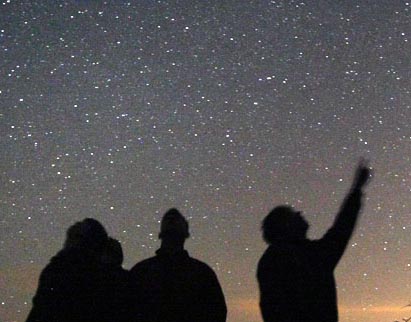
Meet Earendel, the Most Distant Star Astronomers Have Observed
The Hubble Space Telescope has revealed a single star whose light has traveled for 12.9 billion years to Earth — the most distant star known.

The Flames of Orion and a Supergiant Star's End
Astronomers watch starbirth and stardeath, capturing a unique view of a stellar nursery and witnessing a supergiant's supernova.

Stargazing Forecast: Will You Have Clear Skies Tonight?
These websites and apps can help you forecast the astronomical observing conditions for your next night out.

Astrophotography with Jerry Lodriguss
Removing Purple Star Halos
Purple halos around stars can be a problem when shooting with inexpensive camera lenses and telescopes. Here's how to fix them.

New Clues in Cooking up Planets and Stars
An early peak at a forming star system reveals tantalizing clues about its origin.

Explore the Night with Bob King
How Many Pleiades Can YOU See?
Most of us are familiar with the Seven Sisters, but have you met their brothers? Learn how to find more Pleiades than first meet the eye.

Explore the Night with Bob King
9,096 Stars in the Sky—Is That All?
Ten thousand stars bedazzle the eye on a dark night. Wait, how many?

How Many Stars are There in the Universe?
By measuring the number and luminosity of observable galaxies, astronomers put current estimates of the total stellar population of the observable universe at roughly 70 billion trillion.

How Do Stars Die and How Long Do Stars Live?
Both the life and death of a star depend on its mass. Generally speaking, the more massive a star, the faster it burns its fuel and the shorter its life. The most massive stars meet their end in a supernova explosion after only a few million years of fusion, while the tiniest stars continue to feebly burn for upwards of a trillion years.
The Most Distant Star Ever Seen?
Astronomers have detected what might be the farthest star ever spectroscopically observed. The bright object blazes in an unusual location, too, perhaps giving insight into star formation in unconventional environments.
Constellation Names and Abbreviations
Here's all the essential information about the 88 constellations.

The Spectral Types of Stars
Without its spectral type, a star is a meaningless dot of light.
The Stellar Magnitude System
Why do larger numbers mean less light? Here's the story of astronomy's odd but beloved scheme for describing star brightnesses.

Star Names: Where Do They Come From and What Do They Mean?
Confused by the bizarre names that astronomers have given the stars? Here's where they come from and what they mean.
How can binary stars orbit each other so fast?
In a News Note (S&T: November 2004, page 16) you described WR 20a, a binary star in Carina with components of 83 and 82 solar masses and an orbital period of 3.686 days. How can two huge balls of gas move so fast? Grab any introductory astronomy textbook and turn…

If you combine the magnitudes of all visible stars, how bright a star will you come up with?
Just wondering. . . . If you combine the magnitudes of all visible stars (down to 6th magnitude), how bright a star will you come up with? About 9,000 stars are brighter than magnitude 6.5, the traditional criterion for naked-eye visibility. Their combined magnitude is almost exactly –5, which is…

If you lived on Saturn, would its rings be visible from the equator or the poles?
If I lived on Saturn, would its rings be visible from the equator or the poles? Above the cloudtops and neglecting refraction, geometry dictates that you’d see nothing from the poles. As you moved toward the equator, the bright A ring would start coming into view at latitude 66° (roughly…
How can we find the Sun's place among the constellations?
How can I find out how our Sun would look among the constellations, as seen from a nearby star? What made me curious was a painting by space artist David Hardy that pictured the Sun as an extra star in Cassiopeia. Fancy planetarium projectors produce such scenes, but you can…

Were stars artistically depicted with diffraction spikes before the invention of the Newtonian reflector?
Were stars artistically depicted with diffraction spikes before the invention of the Newtonian reflector? If so, why? Stars were being drawn with points or spikes long before Isaac Newton announced his reflecting telescope in 1671. Just look at early works of art, flags, ancient coins, and the charts of the…
